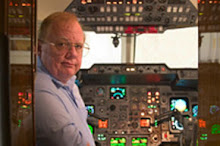When you are considering the purchase of headsets for use in your aircraft, the first thought that often comes to mind is comfort; however, this is not the most important consideration when buying a headset. Modern piston-powered aircraft and helicopters produce high sound levels, often in the range of 90-95db, and present a major challenge to provide both clear communication and adequate hearing protection.
Noise Reduction Methods:
With respect to noise reduction, the two most popular methods for noise reduction today are Passive Noise Reduction (PNR) and Active Noise Reduction (ANR).
Passive Noise Reduction relies upon clamping the earphone over the ear tightly which is accomplished with large ear muffs and strong clamping pressures.
Active Noise Reduction uses technology which allows the manipulation of sound and signal waves to reduce noise, improve signal-to-noise ratios, and enhance sound quality. The electronic coupling of a low frequency noise wave with its exact mirror image cancels this noise. However, active noise cancellation loses most of its effectiveness where it counts the most – in the speech frequencies of 400 Hz to 4,000 Hz. Active noise reduction really only provides effective protection against low frequency noise.
Options:
Ultimately the choice is yours, whether to reduce noise through covering the ears as thoroughly and tightly as possible, or to rely upon the introduction of more sound frequencies to cancel-out outside noise. I would suggest that before you invest a large amount of money into ANR technology you try it out first – you will probably find that PNR technology, uncomfortable as it may be at first, works best in today’s piston powered aircraft.
Today there are a wide range of aviation headset manufacturers. Among them are PilotUSA, David Clark, Bose, and Avcomm, as well as many more. Whatever your choice you can spend as little as $ 115.00 to over $ 1,000 for an aviation headset and still not be happy. When considering the purchase of an aviation headset make sure the dealer offers you the opportunity to try the headset before you can’t return it. Generally speaking you will be pleased with most of the above mentioned headsets, and they will serve you very well.
For extremely high noise conditions the combination of earplugs with earmuffs or communication headsets is recommended when the ambient noise levels are above 115dB. Earplugs, combined with active noise reduction headsets, provide the maximum level of individual hearing protection that can be achieved with current technology.
Passive headsets cancel sound by blocking sound waves. Sound can be blocked by 3 methods: Barriers, Absorption Material, and Damping Methods. In our aviation headsets, we use the ear cup as walls to enclose the ear and act as an acoustical reflector. The ear cups act as a barrier against the path of noise and eliminates energy of the noise wave. The hard barriers target high frequency noise. We also use different types of acoustical foams to absorb the sound waves and eliminate more energy from the sound waves. Vibration isolators which include spring steel equipment mounts, plastic and rubber based bushings and grommets all contribute to noise canceling by damping the noise. These vibration isolators absorb noise coming in through the headband and ear cup stirrups and also noise waves that are bombarding the ear cups.
Active Noise Reduction, or ANR, reduces noise exposure by introducing sound waves 180 degrees out of phase with the noise, resulting in destructive interference, causing a net reduction of noise at the ear. ANR headsets identify and reduce unwanted noise, allowing improved intelligibility of speech received through the radio and intercom audio and provides better hearing protection.
Aircraft noise has been a longtime problem for pilots when it comes to communicating with one another and protecting themselves from hearing loss. Experts say that persistent noise actually induces added fatigue on pilots. Noise canceling performance is far superior to passive noise protection alone, especially in the lower frequency ranges.
The principle of destructive interference of waves is to generate an inverse pressure wave or "anti-noise" to attenuate unwanted noise. The anti-noise is a sound pressure wave which is the exact opposite of the offending noise: it is the mirror image signal, exact in frequency and amplitude but 180 degrees out of phase or "anti-phase" with the unwanted noise. In order to maximize active noise cancellation, the canceling source always produces with great precision an equal but inverted replica of the signal to be canceled.
The graph below shows the noise and mirror image (Anti-Noise) which is 180 degrees out of phase. The result is noise cancellation.

Summary:
Keep in mind the following factors when evaluating headsets:
• Hearing is second only to vision as a sensory mechanism to obtain critical information during
the operation of an aircraft.
• All sounds have three distinctive variables: frequency, intensity, and duration.
• Normal conversation takes place in the frequency range from 500 to 3,000 Hz.
• Daily exposure to noise levels higher than 90dB can cause hearing impairment. This can go unnoticed initially because it occurs in the vicinity of 4,000 Hz (outside the conversational range)
• If the ambient noise level reaches 90dBA, you must use hearing protection equipment to prevent hearing impairment.
• Exposure to loud noise before flying (at home, while driving, at a party, etc.) can be as harmful as exposure to aircraft noise.
Because headsets are an important purchasing decision, I urge you to consider carefully your choice before committing to something that may not serve the purpose you intend it for. If at all possible, buy from a reliable supplier who will allow you to “test fly” the headset first, and give you the option to return it for a full refund without hassle. Price is certainly important, but not as important as getting the right headset for YOUR situation.
At Aviation Sources we are pleased to provide a 30-day Test Flight, and provide a 100% Money-Back Guarantee with each purchase. Check us out today for Your Pilot Supplies ... Delivered!
